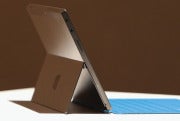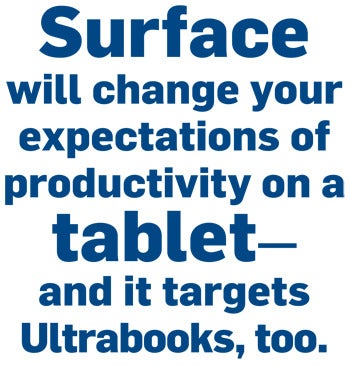 Many unknowns are still to be revealed about Surface. The stakes are high: Market research firm NPD DisplaySearch, for instance, estimates that by 2016 tablet shipments will exceed laptop shipments. Windows 8 tablets could play a significant role in helping to boost tablet sales.
Many unknowns are still to be revealed about Surface. The stakes are high: Market research firm NPD DisplaySearch, for instance, estimates that by 2016 tablet shipments will exceed laptop shipments. Windows 8 tablets could play a significant role in helping to boost tablet sales.
How Much Will It Cost?
Microsoft didn’t reveal what Surface’s pricing would be at launch; rather, the company said that the Windows RT version would cost about the same as comparable tablets, and that the Pro version would target Ultrabook pricing. Those generalities leave a lot of wiggle room.
Consider the Surface RT, which will have 32GB and 64GB versions. Acer’s Iconia Tab A700, an Android competitor, costs $450 with 32GB of storage; the Asus Transformer Pad Infinity TF700 costs $500, also with 32GB of storage. Apple’s third-generation iPad is $499 for 16GB, and $599 for 32GB.
 So, realistically, Surface RT must come in under $500 to be competitive. And even then, Microsoft will face price-pressure challenges from 7-inch tablets, including Google’s Nexus 7 ($249 for 16GB) and a rumored 7-inch Apple iPad that, if it does ship, would be priced competitively with the Nexus 7. Those lower prices will certainly affect what consumers expect to pay for a tablet, regardless of a larger screen size.
So, realistically, Surface RT must come in under $500 to be competitive. And even then, Microsoft will face price-pressure challenges from 7-inch tablets, including Google’s Nexus 7 ($249 for 16GB) and a rumored 7-inch Apple iPad that, if it does ship, would be priced competitively with the Nexus 7. Those lower prices will certainly affect what consumers expect to pay for a tablet, regardless of a larger screen size.
Pricing is equally unclear for the Surface Pro. Ultrabooks, with 128GB to 320GB of storage, are priced at $750 to $1100; 64GB Windows 7 tablets range from $750 to $1099. If Surface Pro with 64GB can hit $800, it will be reasonably competitive. After all, Apple’s 64GB iPad costs $699 today. But if Surface Pro hits $1000 or more, Microsoft’s tablet may seem too pricey.
What Kind of Battery Life Can We Expect?
At its launch event, Microsoft declined to offer battery life estimates. All-day computing remains the holy grail of tablets, and some competitors are getting closer. For instance, in PCWorld’s video-playback test, the Apple iPad lasted 10 hours, 46 minutes; the Google Nexus 7, 10 hours, 10 minutes; the Acer Iconia Tab A700, 8 hours, 11 minutes; and the Asus Transformer Pad Infinity TF700, 7 hours, 58 minutes.
However, even if Surface Pro can’t match those numbers, it needs to stack up well against Ultrabooks, which average around 6 to 7 hours of battery life, and existing Windows 7 tablets, which clock in at 4 to 6 hours of battery life.
Microsoft, we hope, has some battery-stretching secrets up its sleeve. Windows 8 has power-management features to help maximize battery life by optimizing how apps, the OS, and hardware work together. A “Connected Standby” mode lets the machine enter a low-power state, while still receiving up--dates; and Windows 8 Metro apps are designed to take advantage of this mode. Today, though, Connected Standby works only with ARM processors and with Intel’s still-forthcoming system-on-a-chip processor. Current Intel Ivy Bridge Core i3, i5, and i7 CPUs do not support Connected Standby.
Will Surface Have 3G/4G Connectivity?
Microsoft hasn’t yet mentioned Surface support of mobile data options; carrier partnerships may still be in development. Or perhaps Microsoft will skip integrated mobile broadband for the relative simplicity of a Wi-Fi-only version. You can, of course, use either Surface model over Wi-Fi with a mobile hotspot, or with a USB data dongle, for that matter.
When Can We Buy It?
Surface RT should be available when Windows 8 launches in late October. The Surface Pro model is scheduled for approximately three months after the RT version ships, meaning it should be available in early 2013.
